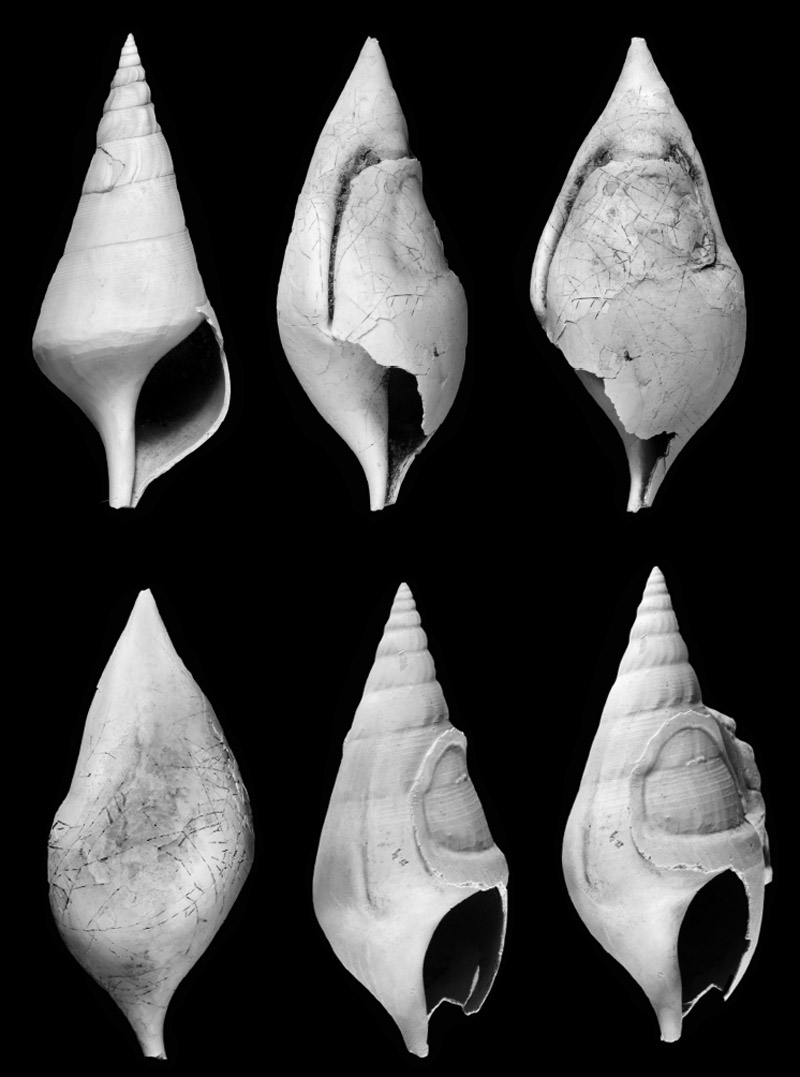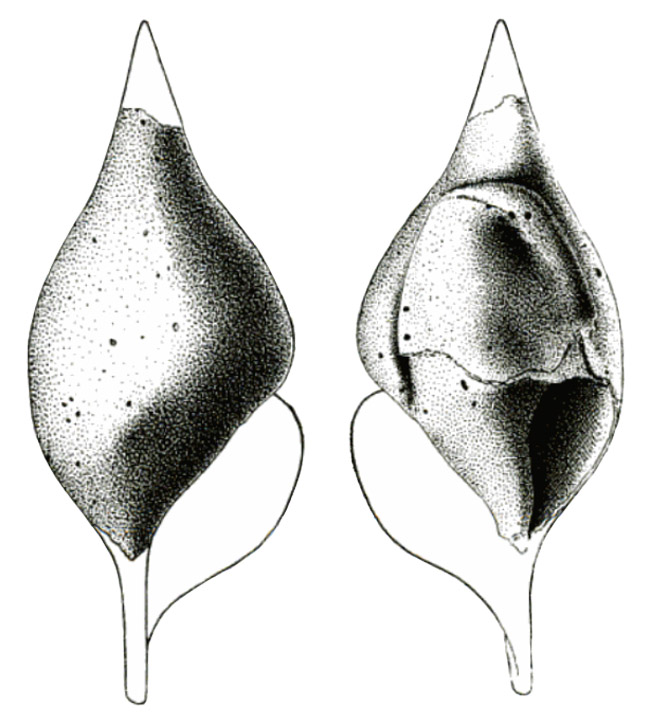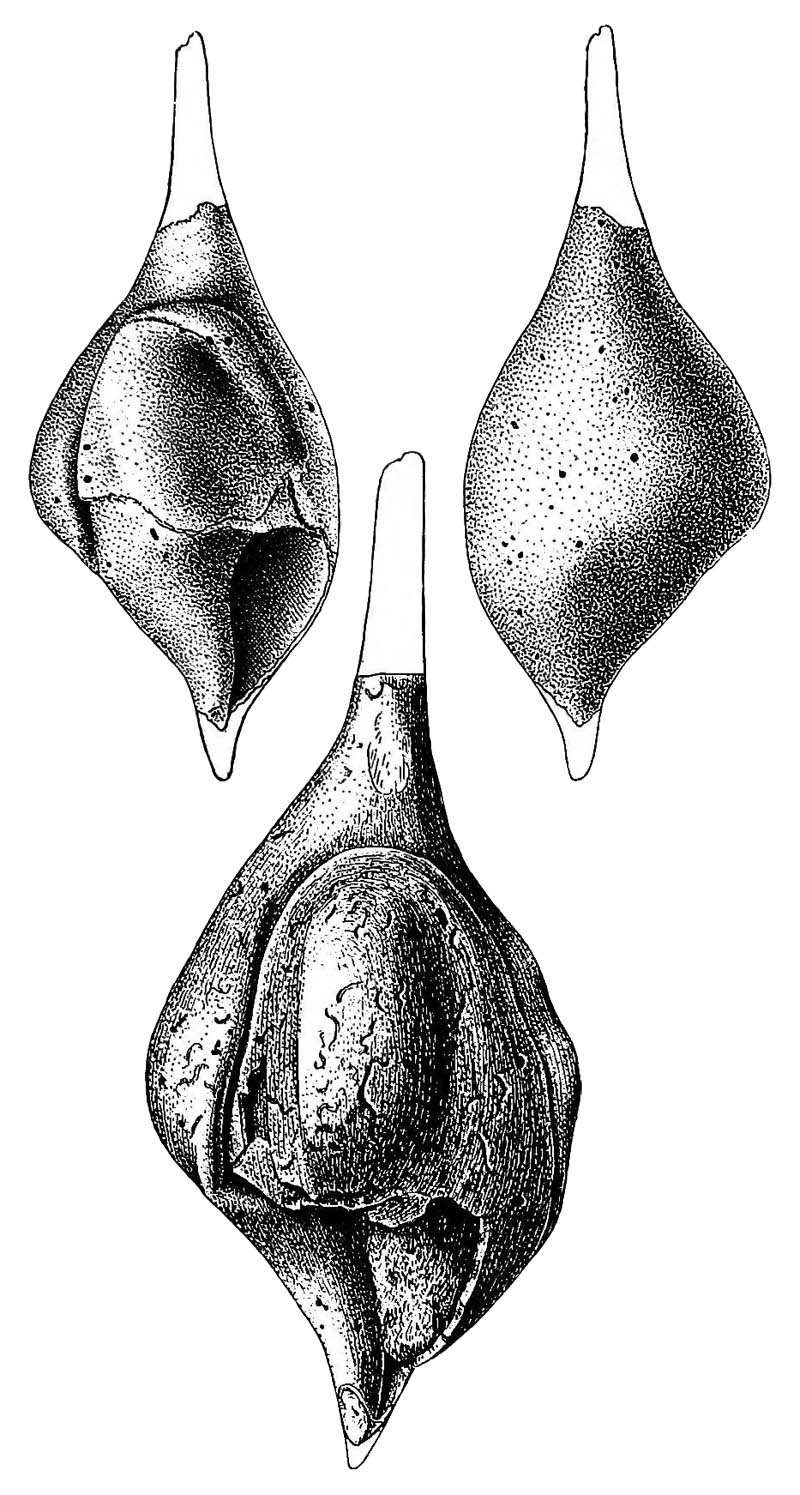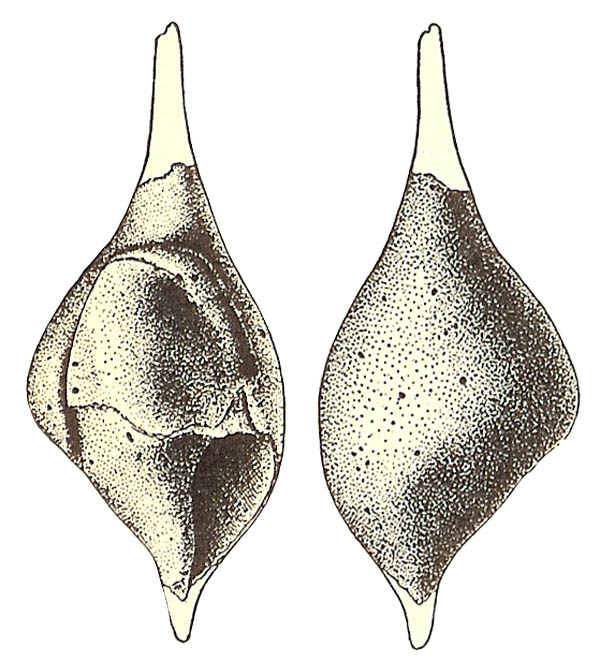Species / Calyptraphorus Jacksoni
Stromboidea
Original Description of Calyptrophorus [sic] jacksoni by Clark, 1896, p. 68:
- "Shell large, solid, many whorled; spire prolonged, acuminate; surface of adult covered with thick, calcareous deposit, entirely enveloping the whorls; inner lip thickened with extensive callosity."
Comment Clark, 1896, p. 68:
- "This very remarkable form is quite distinct from any other species, none of the Gulf types approaching it in size or amount of callosity. Some of the largest specimens of C. trinodifera Conrad show certain points of similarity, but the Maryland species can not be confounded with it. In the absence of young shells, the character of the surface decoration is unknown. A large number of specimens have been found in the South River area."
Locus typicus: "South of Annapolis, near South River, upper Marlboro Md.", Maryland, USA
Stratum typicum: Aquia Formation, Thanetian?, Paleocene
Dimensions: "Length, 75 mm.; width, 30 mm."
Calyptrophorus [sic] jacksoni Clark, 1895, p. 4
History and Synonymy
1896
Calyptrophorus [sic] jacksoni Clark, 1896, pl. 12, figs. 2a, 2b
1901
Clark & Martin, 1901, p. 145 about Calyptraphorus jacksoni:
- This very remarkable form is quite distinct from any other species, but some of the Gulf types approach it in size and amount of callosity. Some pf the largest specimens of C. trinodiferus Conrad show certain points of similarity, but the Maryland species cannot be confounded with it. In the absence of young shells, the character of the surface decoration is unknown. A large number of specimens have been found in the South River area.
- Length (restored), 102 mm.; width, 44 mm.
- Occurrence. — Aquia Formation. South River, Upper Marlboro.
- Collections. — Maryland Geological Survey, Johns Hopkins University, Museum of Comparative Zoology.
Calyptraphorus jacksoni in Clark & Martin, 1901, pl. 25, figs. 1, 1a copy Clark, 1896, fig. 2
Description of Calyptraphorus jacksoni of Clark, 1896 cited by Clark & Martin, 1901:
- "Shell large, solid, many whorled; spire prolonged, acuminate; surface of adult covered with thick, calcareous deposit, entirely enveloping the whorls; inner lip thickened with extensive callosity."
1937
Calyptraphorus jacksoni Palmer, 1937, p. 243
1944
Calyptraphorus jacksoni in Shimer & Shrock, 1944, p. 500, pl. 204, figs. 5, 6 copies Clark & Martin, 1901
1966
Calyptraphorus jacksoni Clark in Palmer & Brann, 1966: 549
2007
Bandel, 2007, p. 130:
- "Calyptraphorus jacksoni CLARK, 1896, was described from the Paleocene of Maryland (CLARK & MARTIN,1901). The same or a very similar species from Matthews Landing on the Alabama River lived on soft bottom in the large bay of the Proto-Gulf of Mexico that at the time was part of the Tethys Sea as well as the Atlantic Ocean. Its protoconch is about 2 mm high and consists of 6 smooth whorls while the first whorl of the teleoconch has axial ribs with collabral curving outline Pl. 3/10–12, 14). Many spiral and lowly rounded ribs separated from each other by narrow grooves crossed by the axial ribs are present on the first three whorls (Pl. 3/12, 14). About 12 axial ribs are present on each these whorls and one or two stronger varices. In the fourth whorl of the teleoconch axial ribs decrease in strength. In the following three whorls they have disappeared and ornament is by fine spiral lines with growth lines crossing which reflect the presence of a low lobe at the rounded corner to the base. The final growth stage was acquired with the formation of the thirteenth whorl. The fully grown shell is between 30 and 40 mm high and of regular conical shape with simple spindle shaped aperture (Pl. 4/1). The thin outer lip had a low basal lobe when transformation to a fully callus covered shell began. This change also included a transformation from rounded diameter of bilaterally compressed shape. Callus began forming independently on the ventral and the dorsal side. On the ventral side the inner lip expanded and on the upper side a curved margin of a wide channel with rounded outer side and a grooved inner side began to be deposited and expanded into a callus plate (Pl. 4/5–6). The change of the shell form to bilateral shape is due to expansion of the inner lip that forms a callus coat on the basal side (Pl. 4/4). Here the corner to the base became evenly rounded on the ventral side and the spire became coated over until its surface was totally concealed by the smooth callus on that side of the shell. The dorsal side of the spire at that stage was still uncovered while the curving channel margin had been deposited on the surface of the body whorl and the pene-ultimate whorls. The layers were spread out from the sides coming from the inner lip as well as the channel of the outer lip until its margins met. During this process the callus cover of the sides increased in thickness more strongly. The apical angle was thus increased from about 35° to 45°. On the upper shell side the callus covers the apex of the spire and continues in a smooth wide ridge on the margin of the groove (Pl. 4/2–3). This latter is the continuation of the at first wide, latter continuously narrower posterior end of the aperture. The original sinus on the back of the shell thus became a narrow groove in the dorsal callus pad (Pl. 4/3–4). It ends on the other side at about the same height as the aperture of the shell. Thus a central shield was deposited with a rim next to the groove and a thick callus continuation on top of the last whorl above the aperture. The central part of the shield is a depression of a thinner callus covering the whorls of the spire (Pl. 4/3). When the shell was totally covered it acquired bilateral shape with sides wider due to the callus added there in greater thickness. Summarizing shell growth of Calyptrophorus jacksoni it can be recognized that it is totally without callus deposits until grown to full height (Pl. 4/1). The callus formed afterwards expands from two sources, one representing the mantle that covered the inner lip and deposited callus on the side of the shell that was always in contact with the sediment, the other representing a lobe of the mantle that extended from the apical end of the aperture in a similar manner as was the case in the Rimella and Ectinochilus relation. In contrast to the later the dorsal canal was wider when callus deposition began (Pl. 4/5–6), and expanded with callus deposition. In fully outgrown shells both callus fields met and fused with each other."

Calyptraphorus jacksoni in Bandel, 2007, pl. 4, figs. 1 - 6
- Fig. 1: Calyptraphorus jacksoni with the shell 35 mm high is fully grown in size, but has no callus cover.
- Fig. 2: Calyptraphorus jacksoni from the Paleocene of Matthews Landing on Alabama River seen from the side with full callus cover and the apical canal.
- Fig. 3: Calyptraphorus jacksoni of the same as in Fig. 2 seen with the callus covered ventral side that is flattened and the sides are thickened by the deposits.
- Fig. 4: Calyptraphorus jacksoni of same as in Fig. 2 seen with the callus groove on the dorsal side where ventral callus extended over the spire and dorsal callus meet in the margin of the curving canal.
- Fig. 5: Calyptraphorus jacksoni with begin of callus cover and wide groove on the side (same as Fig. 6)
- Fig. 6: Calyptraphorus jacksoni of the same as in Fig. 5 with the dorsal side and the round shape of the margin of the groove.
References




